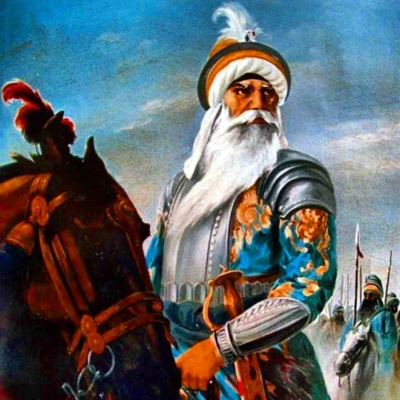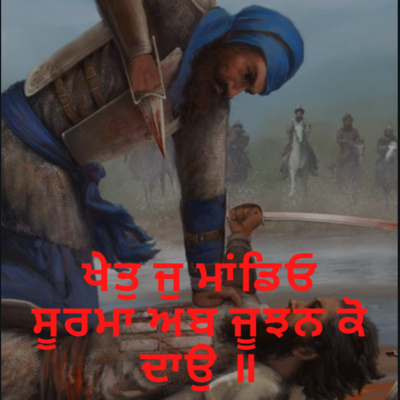The way it works is that there are two central Nihang Armies which were resurrected by Akali Phoola Singh after the demise of his predecessor Naina Singh Nihang. Basically, Nawab Kapur Singh had structured the entire Panth between the Budha and Tarna Dals. Reason for this was to preserve the life of the Sikh populace while also being able to move fast to meet any military exigencies.
The Nihangs of Kapur Singh's days were divided into two ranks: Akali and Nihang. Akalis were the veterans of Guru Gobind Singh Ji's days, Baba Banda Singh's days and had split after Banda Singh's betrayal. Some had joined the treacherous Binod Singh and Kahn Singh who lived off Mughal largesse. The rest took to the forests of North India. A certain few received pension from the Mughals for staying silent. They, however, convinced the Mughals to their sincerity but clandestinely trained Sikh youth for battle.
The Sikh battle dress at the time was either black or blue. The Akalis were distinguished by the fluttering pieces of cloth or feathers atop their turban. Given their itinerant nature and application as a Quick Reaction Force, Kapur Singh organized them into the Shahid or Martyr's Misl. They were made a preliminary Gurudwara task force, remained a Quick Reaction Force and also charged with initiating converts to Sikhi after testing them and acting as a people's judiciary.
However after Kapur Singh's demise and that of his successor Baba Jassa Singh Alhuwalia, the Misls fell into disarray. The Shahids were commandeered by Naina Singh Akali, a veteran of Baba Dip Singh's campaigns. Fanatical, he was unable to control the Nihangs from becoming corrupted. By the time of Ranjit Singh, the Nihangs acquiesced to work alongside the Khalsa forces but retained their independence. After Kapur Singh, Jassa Singh organized the Misls into the Dals. After Jassa Singh, this system was discarded but Phoola Singh resurrected it but solely for the Nihangs given Ranjit Singh introduced his own innovations into the Sikh ranking system.
So far, no Sikh historian has explored Sikh military ranks in the pre-Empire era. After the Nihangs were nearly wiped out from the Punjab by the British they sought refuge at Hazur Sahib from where only three returned after thirty years. They were from the Budha-Dal with the Tarna Dal having remained intact in the Punjab. Over the next few decades, the British allowed the Nihangs to increase well aware that their belligerent nature would not allow the Sikhs to progress very far.
The leadership structure the current Nihangs have hearkens back to British days or earlier.
Veteran Nihangs are called Akalis and have the farla dastaar. Within the current Nihang tradition they are referred to as Mahakaals.
Among these veterans, one is selected to be the premier Jathedar of the Dal. All other sub-Dals are under his command.
Second to this Jathedar is a vice Jathedar who often organizes and leads the Chalda-Vaheer, the itinerant part of any Nihang Dal. As a rule of thumb, the Vaheer moves every three days.
Then we have a senior Jathedar in charge of seeing to the horses, livestock and vehicles which the Dal has.
Accompanying this latter Jathedar is a senior-most Shastars expert who is charged with maintaining and purchasing weapons for the Dal.
We then have Jathedars proficient in Katha and Kirtan.
Down the chain of command are the subordinate Nihangs who don't have the farla. They take care of other issues such as Shaheedi Degh, Langar, labor etc.
Ultimately, bottommost rung is occupied by Singhs, i.e. Nihangs in training.
The scant information furnished to us indicates that historically:
Akalis were always on the move as regular troops. The Singhs were irregulars who came to serve for some time and then left. On duty they were called Nihangs. The historic practice was that only a Singh who had been a Nihang for 20 years straight, was above 40 years of age and proficient in military arts was given a farla and made an Akali and that too if they had a steadfast Sikh character.
Today we have multiple Dals organized around the Budha and Tarna Dals. All follow the same structure.
For a bit more information, please listen to:
Rediscovering Banda Singh Bahadur-The Man Behind The Myth by The Sikh Renaissance
Nawab Kapur Singh-the charismatic but equally enigmatic 18th century Sikh leader who captained the Khalsa Panth during its darkest days in the post-Banda Singh period. What we know of him is derived from a few scant references in the Sri Gur Panth Prakash of Ratan Singh Bhangu, the oral...

anchor.fm
Bhai Sukha Singh (1721-1753) was an eighteenth century convert to Sikhi who became synonymous with the Khalsa military ethos during his lifetime. Stoic in the face of pain, he was a man of high dynamism who straddled both the military and political spectrums effortlessly. Famed, and somewhat...

anchor.fm
The term Nihang though is not etymologically Sikh and Persian accounts mention even mercenaries to be Nihangs.



